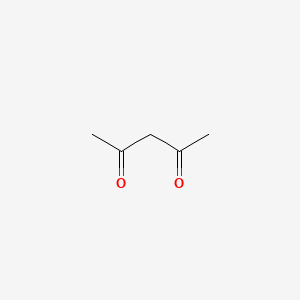| MeSH term | MeSH ID | Detail |
|---|---|---|
| Purpura, Thrombocytopenic | D011696 | 2 associated lipids |
| Eczema | D004485 | 4 associated lipids |
| Fetal Resorption | D005327 | 15 associated lipids |
| Carcinoma, Lewis Lung | D018827 | 22 associated lipids |
| Nervous System Diseases | D009422 | 37 associated lipids |
| Dermatitis, Contact | D003877 | 59 associated lipids |
| Seizures | D012640 | 87 associated lipids |
| Glioma | D005910 | 112 associated lipids |
| Edema | D004487 | 152 associated lipids |
| Adenocarcinoma | D000230 | 166 associated lipids |
2,4-pentanedione
2,4-pentanedione is a lipid of Fatty Acyls (FA) class. The related lipids are Butyrates.
Cross Reference
Introduction
To understand associated biological information of 2,4-pentanedione, we collected biological information of abnormalities, associated pathways, cellular/molecular locations, biological functions, related genes/proteins, lipids and common seen animal/experimental models with organized paragraphs from literatures.
What diseases are associated with 2,4-pentanedione?
There are no associated biomedical information in the current reference collection.
Possible diseases from mapped MeSH terms on references
We collected disease MeSH terms mapped to the references associated with 2,4-pentanedione
PubChem Associated disorders and diseases
What pathways are associated with 2,4-pentanedione
There are no associated biomedical information in the current reference collection.
PubChem Biomolecular Interactions and Pathways
Link to PubChem Biomolecular Interactions and PathwaysWhat cellular locations are associated with 2,4-pentanedione?
There are no associated biomedical information in the current reference collection.
What functions are associated with 2,4-pentanedione?
There are no associated biomedical information in the current reference collection.
What lipids are associated with 2,4-pentanedione?
Related references are published most in these journals:
| Lipid concept | Cross reference | Weighted score | Related literatures |
|---|
What genes are associated with 2,4-pentanedione?
There are no associated biomedical information in the current reference collection.
What common seen animal models are associated with 2,4-pentanedione?
There are no associated biomedical information in the current reference collection.
NCBI Entrez Crosslinks
All references with 2,4-pentanedione
Download all related citations| Authors | Title | Published | Journal | PubMed Link |
|---|---|---|---|---|
| Ling YP and Heng LY | A potentiometric formaldehyde biosensor based on immobilization of alcohol oxidase on acryloxysuccinimide-modified acrylic microspheres. | 2010 | Sensors (Basel) | pmid:22163450 |
| Lv W et al. | Optically active homoleptic bis(phthalocyaninato) rare earth double-decker complexes bearing peripheral chiral menthol moieties: effect of pi-pi interaction on the chiral information transfer at the molecular level. | 2010 | Inorg Chem | pmid:20545317 |
| Venter GJ et al. | 4-[(4-Methyl-phen-yl)amino]-pent-3-en-2-one. | 2010 | Acta Crystallogr Sect E Struct Rep Online | pmid:21589171 |
| Oh YK | Acid-base disorders in ICU patients. | 2010 | Electrolyte Blood Press | pmid:21468199 |
| Salthammer T et al. | Formaldehyde in the indoor environment. | 2010 | Chem. Rev. | pmid:20067232 |
| Coen PM et al. | Insulin resistance is associated with higher intramyocellular triglycerides in type I but not type II myocytes concomitant with higher ceramide content. | 2010 | Diabetes | pmid:19833891 |
| Athanasellis G et al. | Tetramic and tetronic acids as scaffolds in bioinorganic and bioorganic chemistry. | 2010 | Bioinorg Chem Appl | pmid:20508811 |
| Wu TY et al. | Synthesis and characterization of organic dyes containing various donors and acceptors. | 2010 | Int J Mol Sci | pmid:20162019 |
| Pacenti M et al. | New automated and high-throughput quantitative analysis of urinary ketones by multifiber exchange-solid phase microextraction coupled to fast gas chromatography/negative chemical-electron ionization/mass spectrometry. | 2010 | J Autom Methods Manag Chem | pmid:20628512 |
| Smits ML et al. | Holmium-166 radioembolization for the treatment of patients with liver metastases: design of the phase I HEPAR trial. | 2010 | J. Exp. Clin. Cancer Res. | pmid:20550679 |
| Hanson-Smith V et al. | Robustness of ancestral sequence reconstruction to phylogenetic uncertainty. | 2010 | Mol. Biol. Evol. | pmid:20368266 |
| Schlafer S et al. | Filifactor alocis--involvement in periodontal biofilms. | 2010 | BMC Microbiol. | pmid:20193074 |
| Chou WL et al. | [(Pyrrolidin-1-yl)carbothio-ylsulfan-yl]methyl pyrrolidine-1-carbodithio-ate. | 2010 | Acta Crystallogr Sect E Struct Rep Online | pmid:21589487 |
| Jones PG et al. | mer-[3-Phenyl-5-(2-pyridyl-κN)-1,2,4-triazol-1-ido-κN]bis-(2-quinolylphenyl-κC,N)iridium(III) deuterochloro-form disolvate. | 2010 | Acta Crystallogr Sect E Struct Rep Online | pmid:21588839 |
| Brink A et al. | Tetra-ethyl-ammonium (acetyl-acetonato)bromidotricarbonyl-rhenate(I). | 2010 | Acta Crystallogr Sect E Struct Rep Online | pmid:21522557 |
| Ghanti E and Nagarajan R | Synthesis of CuAl2(acac)4(O(i)Pr)4, its hydrolysis and formation of bulk CuAl2O4 from the hydrolyzed gels; a case study of molecules to materials. | 2010 | Dalton Trans | pmid:20571649 |
| Escobar AJ and Castaño DM | Classifying glycerol dehydratase by its functional residues and purifying selection in its evolution. | 2010 | Bioinformation | pmid:21364782 |
| Schlund S et al. | Predicting the tautomeric equilibrium of acetylacetone in solution. I. The right answer for the wrong reason? | 2010 | J Comput Chem | pmid:19557765 |
| Liang H and Xie F | Photoluminescence study of a europium (III) complex containing 1,5-styrylacetylacetone ligands. | 2010 | Spectrochim Acta A Mol Biomol Spectrosc | pmid:20634125 |
| Bunkoed O et al. | Sol-gel based sensor for selective formaldehyde determination. | 2010 | Anal. Chim. Acta | pmid:20103132 |
